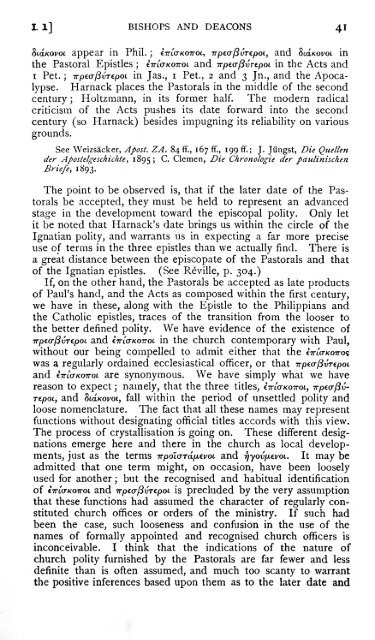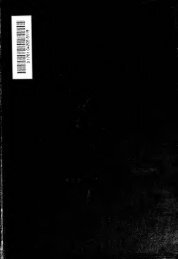Philippians and Philemon - MR Vincent - 1906.pdf
Philippians and Philemon - MR Vincent - 1906.pdf
Philippians and Philemon - MR Vincent - 1906.pdf
Create successful ePaper yourself
Turn your PDF publications into a flip-book with our unique Google optimized e-Paper software.
I. 1] BISHOPS AND DEACONS 4<br />
SiaKOvoL appear in Phil. ;,,<strong>and</strong> in<br />
the Pastoral Epistles ; <strong>and</strong> in the Acts <strong>and</strong><br />
I Pet. ; in Jas., i Pet., 2 <strong>and</strong> 3 Jn., <strong>and</strong> the Apocalypse.<br />
Harnack places the Pastorals in the middle of the second<br />
century ; Holtzmann, in its former half. The modern radical<br />
criticism of the Acts pushes its date forward into the second<br />
century (so Harnack) besides impugning its reliability on various<br />
grounds.<br />
See Weizsacker, Aposi. A. 84 ff., 167 if., 199 ff.; J. Jungst, Die QuelUn<br />
der Apostelgeschichte, 1895; C. Clemen, Die Chronologie der paulinischen<br />
Briefe, 1893.<br />
The point to be observed is, that if the later date of the Pastorals<br />
be accepted, they must be held to represent an advanced<br />
stage in the development toward the episcopal poUty. Only let<br />
it be noted that Harnack's date brings us within the circle of the<br />
Ignatian polity, <strong>and</strong> warrants us in expecting a far more precise<br />
use of terms in the three epistles than we actually find. There is<br />
a great distance between the episcopate of the Pastorals <strong>and</strong> that<br />
of the Ignatian epistles. (See R^ville, p. 304.)<br />
If, on the other h<strong>and</strong>, the Pastorals be accepted as late products<br />
of Paul's h<strong>and</strong>, <strong>and</strong> the Acts as composed within the first century,<br />
we have in these, along with the Epistle to the <strong>Philippians</strong> <strong>and</strong><br />
the Catholic epistles, traces of the transition from the looser to<br />
the better defined poUty. We have evidence of the existence of<br />
<strong>and</strong> in the church contemporary with Paul,<br />
without our being compelled to admit either that the<br />
was a regularly ordained ecclesiastical officer, or that<br />
<strong>and</strong> are synonymous. We have simply what we have<br />
, <strong>and</strong>,fall within the period of unsettled polity <strong>and</strong><br />
loose nomenclature. The fact that all these names may represent<br />
functions without designating official titles accords with this view.<br />
The process of crystallisation is going on. These different designations<br />
emerge here <strong>and</strong> there in the church as local developments,<br />
just as the terms <strong>and</strong>. It may be<br />
admitted that one term might, on occasion, have been loosely<br />
used for another ; but the recognised <strong>and</strong> habitual identification<br />
of <strong>and</strong> is precluded by the very assumption<br />
that these functions had assumed the character of regularly constituted<br />
church offices or orders of the ministry. If such had<br />
been the case, such looseness <strong>and</strong> confusion in the use of the<br />
names of formally appointed <strong>and</strong> recognised church officers is<br />
inconceivable. I think that the indications of the nature of<br />
church polity furnished by the Pastorals are far fewer <strong>and</strong> less<br />
definite than is often assumed, <strong>and</strong> much too scanty to warrant<br />
the positive inferences based upon them as to the later date <strong>and</strong><br />
reason to expect ; namely, that the three titles,,-<br />
1





